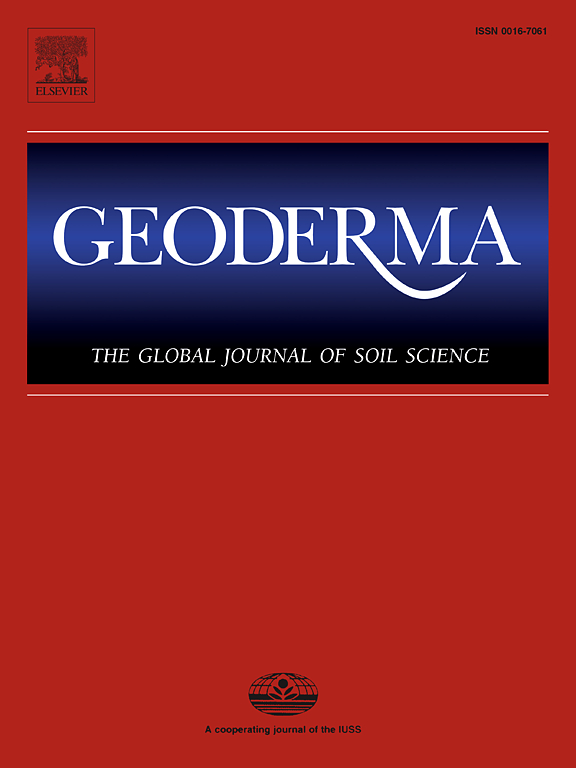Predicting the thickness of alpine meadow soil on headwater hillslopes of the Qinghai-Tibet Plateau
IF 5.6
1区 农林科学
Q1 SOIL SCIENCE
引用次数: 0
Abstract
Alpine meadow soils in tectonically active High Mountain Asia (HMA) are highly vulnerable, playing a critical role in the fragile ecosystems of Earth’s “Third Pole”. Understanding the formation and distribution of these soils is essential, yet the mechanisms governing their thickness remain unclear. To address this, we applied a multi-resolution (0.25–30.00 m) stochastic approach to predict soil thickness in a nested headwater catchment in the Lhasa River Basin, namely D5K (415 sites) and its headwater sub-catchment D5KH1 (330 sites). Using a linear mixed-effects model, we quantified uncertainty through within-site and between-site variance analysis, and compared the performance of deep learning (DL) with three traditional machine learning methods—random forest (RF), support vector machine (SVM), and artificial neural networks (ANN)—under three variable selection strategies: (1) all variables, (2) stepwise selection, and (3) a novel Boruta-based recursive method. Field investigations revealed that organic matter accumulation and freeze–thaw cycles are dominant pedogenic factors, producing a root-dense turf layer beneath a dark humus horizon. Freeze-thaw dynamics also contribute to geomorphological features such as landslides and stone stripes. Soil thickness varied significantly across topographic positions—valleys, sideslopes, and ridges (p < 0.001)—with within-site variance (SD = 11.06 cm) slightly exceeding between-site variance (SD = 9.58 cm). Fine-resolution digital elevation models (DEMs) effectively captured these variations, largely because they incorporate critical topographic factors such as the Topographic Position Index (TPI), which Boruta analysis identified as more influential on soil thickness than flow-related indices like the Topographic Wetness Index. Among the tested models, RF combined with the Boruta method and a 0.25 m resolution DEM provided the most accurate predictions, outperforming DL. These findings emphasize that the complexity of DL may not translate into superior performance for all applications, particularly in small dataset terrain-driven ecological studies.
青藏高原源头坡地高寒草甸土壤厚度预测
在构造活跃的亚洲高山地区,高寒草甸土壤非常脆弱,在地球“第三极”脆弱生态系统中起着至关重要的作用。了解这些土壤的形成和分布是必不可少的,但控制其厚度的机制仍不清楚。为了解决这一问题,我们采用了多分辨率(0.25-30.00 m)随机方法来预测拉萨河流域一个巢式水源集水区的土壤厚度,即D5K(415个点)及其水源子集水区D5KH1(330个点)。采用线性混合效应模型,通过站点内和站点间方差分析量化不确定性,并比较深度学习(DL)与三种传统机器学习方法(随机森林(RF)、支持向量机(SVM)和人工神经网络(ANN))在三种变量选择策略下的表现:(1)所有变量,(2)逐步选择,(3)基于boruta的新递归方法。野外调查表明,有机质积累和冻融循环是主要的成土因素,在黑暗腐殖质层下形成根系密集的草皮层。冻融动力学也有助于地貌特征,如滑坡和石纹。土壤厚度在不同地形位置(山谷、山坡和山脊)之间变化显著(p <;0.001),站点内方差(SD = 11.06 cm)略大于站点间方差(SD = 9.58 cm)。精细分辨率数字高程模型(dem)有效地捕捉到了这些变化,主要是因为它们包含了关键的地形因素,如地形位置指数(TPI), Boruta分析发现,与地形湿度指数等与流量相关的指数相比,TPI对土壤厚度的影响更大。在测试的模型中,RF结合Boruta方法和0.25 m分辨率DEM提供了最准确的预测,优于DL。这些发现强调,深度学习的复杂性可能不会转化为所有应用的优越性能,特别是在小数据集地形驱动的生态研究中。
本文章由计算机程序翻译,如有差异,请以英文原文为准。
求助全文
约1分钟内获得全文
求助全文
来源期刊

Geoderma
农林科学-土壤科学
CiteScore
11.80
自引率
6.60%
发文量
597
审稿时长
58 days
期刊介绍:
Geoderma - the global journal of soil science - welcomes authors, readers and soil research from all parts of the world, encourages worldwide soil studies, and embraces all aspects of soil science and its associated pedagogy. The journal particularly welcomes interdisciplinary work focusing on dynamic soil processes and functions across space and time.
 求助内容:
求助内容: 应助结果提醒方式:
应助结果提醒方式:


